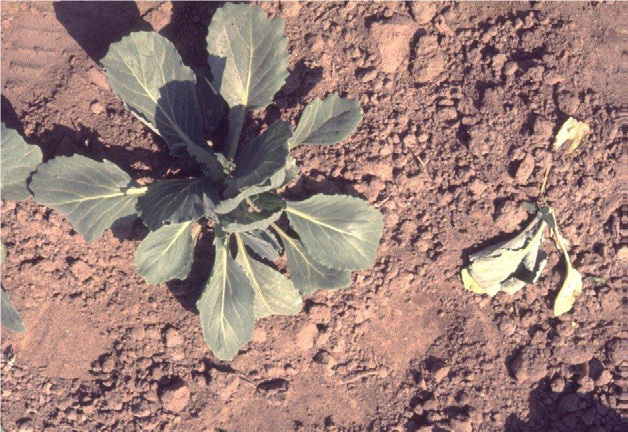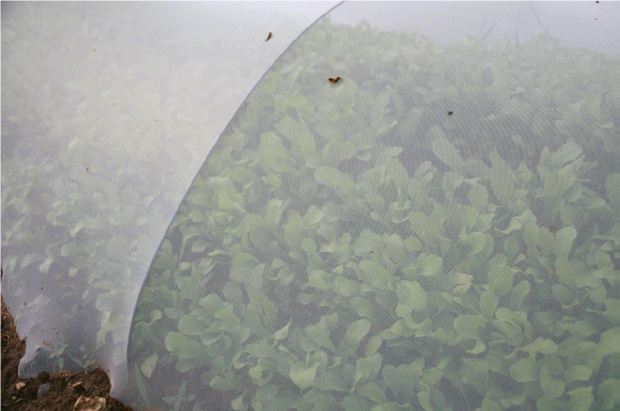The cabbage maggot, Delia radicum, is one of the most destructive early season pests of crucifers and certain root crops in New Hampshire. It can cause severe injury to cabbage, cauliflowers, broccoli, Brussels sprouts, radishes, turnips, rutabaga, beets, and celery if not controlled.

cabbage maggot (right). Credit: D. W. Sutherland, University of New
Hampshire.
Description
The adult fly is similar in appearance to the common house fly, but smaller (1/4" long). It is dark, ashy-gray with black stripes on its thorax and black bristles cover its body. In spring, females are commonly seen flying close to the ground, depositing small white eggs in cracks and crevices near the stems of host plants.
The larvae that emerge from the eggs are white, legless, tapered maggots that feed on the roots of cole crops. The maggots later change to hard, brown, egg-shaped pupae about 1/4" long.

and several pupae. Credit: D. W. Sutherland, University of New Hampshire.
Life Cycle
The cabbage maggot spends winter as a pupa, 1 to 5" deep in the soil. When the soil warms up in spring, about the time gardeners are setting out transplants, the adults emerge, mate, and lay eggs on the soil near host plants.
The eggs hatch in 3 to 7 days and the small maggots seek out roots and begin feeding. They destroy plant roots by tunneling, which often causes young cabbage, broccoli, and cauliflower seedlings to wilt and die. Plants like radish and turnip become scored with feeding trails, making them susceptible to attack by disease organisms.
The larvae complete development in 3-4 weeks and begin pupating. In 2 to 3 weeks, usually in late June and July, the adults emerge and work their way through the soil to the surface to start a new generation. There are typically 3 or 4 generations of cabbage maggot each growing season in New Hampshire. Damage is worst in early spring, and lowest in mid-summer.

Management
IPM Strategies:
Cultural Practices
- Row covers - Cover cabbage family transplants or newly-seeded rows with floating row covers until June 1, or delay planting until then to foil the first generation of egg-laying cabbage maggot flies.
- Barriers - Alternatively, protect cabbage, broccoli, cauliflower, and other cole crop transplants with barriers made by punching a hole in the center of a 6" square of tarpaper and slitting the paper from one corner to the center hole. Then, place the tarpaper square flat on the ground, with center hole snugly encircling the stem of the transplant.
- Crop Rotation - Rotate spring crops to a field that was not planted previously with Brassica crops.
Biological Control
- There are a number of natural predators that feed on cabbage maggot eggs, larvae, and pupae. They can cause high levels of mortality.
Chemical Control
- Direct application of insecticides to the root zone is considered the most effective means for controlling maggot damage. Consult your county Agricultural Field Specialist for specific recommendations.

Stop! Read the label on every pesticide container each time before using the material. Pesticides must be applied only as directed on the label to be in compliance with the law. All pesticides listed in this publication are contingent upon continued registration. Contact the Division of Pesticide Control at (603) 271-3550 to check registration status. Dispose of empty containers safely, according to New Hampshire regulations.
Download the resource for the complete factsheet.

